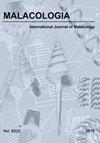An Integrative Approach for the Identification of Native and Exotic Lymnaeids from Brazil
IF 1
4区 生物学
Q4 ZOOLOGY
引用次数: 0
Abstract
ABSTRACT Many freshwater snail species of the family Lymnaeidae are known to act as intermediate hosts of Fasciola hepatica, the causative agent of fasciolosis, a parasitic disease of great veterinary and medical importance. Morphological identification of lymnaeid species is based on characteristics of shell, reproductive and renal systems. However, such identification is challenging due to interspecific similarity, which is particularly evident among the species Galba viator, G. cubensis, and G. truncatula. To overcome these difficulties, we used molecular markers and a morphological approach applied to specimens from Brazil to compare the data obtained with type specimens, topotypes, and other lymnaeid species. We used PCR-RFLP with MboII, HpaII, and AluI enzymes directed to the ITS2-rDNA region, which allowed differentiation among Pseudosuccinea columella, Pectinidens diaphanus, G. viator, G. cubensis, and G. truncatula when morphological characterization is inconclusive. These results allowed us to report for the first time the occurrence of G. cubensis and G. truncatula in the state of Minas Gerais, Brazil. We also performed phylogenetic analyses using 16S mtDNA sequences, which corroborated the PCR-RFLP results. The molecular techniques used in this study aimed to support the morphological identification of Lymnaeidae populations from Brazil and have proven to be a helpful tool when morphological analysis does not support confident identification at the species level.巴西本地和外来Lymnaeids的综合鉴定方法
摘要众所周知,Lymnaedae科的许多淡水蜗牛物种是肝片吸虫的中间宿主,肝片吸虫病是一种具有重要兽医和医学意义的寄生虫病。lymnaeid物种的形态鉴定是基于外壳、生殖和肾脏系统的特征。然而,由于种间的相似性,这种鉴定是具有挑战性的,这在Galba viator、G.cubensis和G.truncatula物种中尤为明显。为了克服这些困难,我们使用分子标记和应用于巴西标本的形态学方法,将获得的数据与模式标本、地形类型和其他lymnaeid物种进行比较。我们使用针对ITS2 rDNA区域的MboII、Hpall和AluI酶的PCR-RFLP,当形态特征不确定时,可以在柱状假琥珀、透明山核桃、维亚托山核桃、立方山核桃和截断山核桃之间进行分化。这些结果使我们首次报道了巴西米纳斯吉拉斯州库本斯G.cubensis和截断G.truncatula的发生。我们还使用16S mtDNA序列进行了系统发育分析,这证实了PCR-RFLP的结果。本研究中使用的分子技术旨在支持巴西Lymnaedae种群的形态鉴定,并已被证明是一种有用的工具,当形态分析不支持在物种水平上进行可靠的鉴定时。
本文章由计算机程序翻译,如有差异,请以英文原文为准。
求助全文
约1分钟内获得全文
求助全文
来源期刊

Malacologia
生物-动物学
CiteScore
2.00
自引率
0.00%
发文量
15
审稿时长
3 months
期刊介绍:
Malacologia publishes papers on all groups of the Mollusca. Malacologia specializes in publishing long papers and monographic treatments. Complete data are especially appreciated. Papers must be of interest to an international readership. Papers in systematics, ecology, population ecology, genetics, molecular genetics, evolution and phylogenetic treatments are especially welcomed. Also welcomed are letters to the editor involving papers published or issues of import to science of the day.
 求助内容:
求助内容: 应助结果提醒方式:
应助结果提醒方式:


